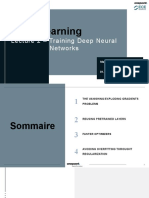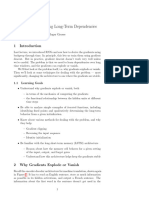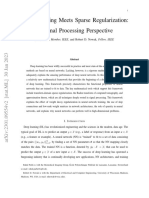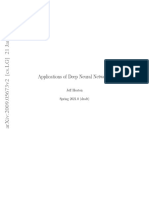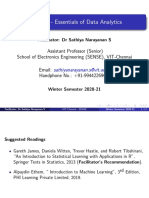Name- Mohd Eisa
Reg Email- mdeisa6972@gmail.com
Course Name- Full Stack Data Science Pro
Assignment Name- Weight Initialization Techniques Assignment Questions
1. What is the vanishing gradient problem in deep neural
networks? How does it affect training?
The vanishing gradient problem occurs when gradients of the loss function become extremely
small during backpropagation, particularly in very deep neural networks. This happens because
gradients are multiplied layer by layer, and if the derivatives are small (e.g., using sigmoid or
tanh activation functions), they shrink exponentially as they propagate backward.
Effects on Training:
a. Slow or Stalled Learning: Early layers in the network fail to learn effectively
because their weights are not updated significantly.
b. Poor Optimization: The network may struggle to converge to an optimal
solution, resulting in suboptimal performance.
c. Imbalance in Learning: Later layers learn better while earlier layers remain
stagnant, leading to models that focus on shallow features rather than deep
hierarchical patterns.
d. Limits Network Depth: Makes it difficult to train very deep networks, restricting
their ability to capture complex features.
How It Is Addressed:
e. Using ReLU and Variants: ReLU and its variants (e.g., Leaky ReLU) avoid
vanishing gradients by having a constant gradient for positive inputs.
f. Adding Residual Connections: Techniques like residual learning in ResNet
allow gradients to bypass certain layers, maintaining their strength throughout
backpropagation.
g. Applying Batch Normalization: Normalizes activations, stabilizing gradients
and ensuring they do not vanish or explode.
h. Better Weight Initialization: Methods like Xavier or He initialization start weights
in a range that prevents gradients from diminishing excessively during
backpropagation.
In summary, the vanishing gradient problem hinders the training of deep networks by stalling
updates in earlier layers, but modern techniques have largely mitigated this issue, enabling the
training of very deep and effective models.
� 2. Explain how Xavier initialization addresses the vanishing
gradient problem.
Xavier initialization addresses the vanishing gradient problem by ensuring that the variance of
activations and gradients remains stable across the layers of a neural network. It does this by
carefully initializing the weights based on the number of input and output neurons in each layer.
For Xavier initialization:
● Weights are drawn from a uniform distribution within the range −sqrt(6/(number of
inputs+number of outputs))-sqrt(6 / (number of inputs + number of
outputs))−sqrt(6/(number of inputs+number of outputs)) to sqrt(6/(number of
inputs+number of outputs))sqrt(6 / (number of inputs + number of
outputs))sqrt(6/(number of inputs+number of outputs)), or
● From a normal distribution with a mean of 0 and a variance of 1/(number of
inputs+number of outputs)1 / (number of inputs + number of outputs)1/(number of
inputs+number of outputs).
Key Benefits:
1. Prevents Vanishing Gradients:
○ By stabilizing the variance of gradients during backpropagation, it avoids the
situation where gradients become too small to effectively update weights.
2. Maintains Activation Variance:
○ Ensures that the variance of activations remains constant across layers,
preventing activations from shrinking as they propagate forward.
3. Balances Input and Output:
○ Consider both the number of inputs and outputs for each layer, ensuring that
weight initialization does not favor one direction over the other.
Xavier initialization is particularly effective for activation functions like sigmoid and tanh, which
are prone to vanishing gradients. However, for activation functions like ReLU, He initialization (a
variant of Xavier) is typically preferred. By stabilizing gradients and activations, Xavier
initialization helps deep networks train more efficiently and reliably.
3. What are some common activation functions that are prone to
causing vanishing gradients?
Sigmoid Activation Function:
a. The sigmoid function maps input values into the range (0, 1).
b. Why it causes vanishing gradients:
� i. For very large or very small input values, the gradient of the sigmoid
function approaches zero, leading to negligible updates in weights during
backpropagation.
ii. This problem is exacerbated in deep networks where gradients are
multiplied across many layers.
Tanh Activation Function:
c. The tanh function maps input values into the range (-1, 1).
d. Why it causes vanishing gradients:
i. Similar to the sigmoid function, the tanh function saturates for large
positive or negative inputs, resulting in gradients close to zero.
ii. While it centers activations around zero (which can help in some cases), it
still suffers from vanishing gradients in deeper networks.
Softmax Activation Function:
e. Softmax is typically used in the output layer of classification networks to convert
logits into probabilities.
f. Why it causes vanishing gradients:
i. When applied to extremely large or small logits, softmax probabilities
become very close to 0 or 1, causing gradients to shrink during
backpropagation.
ii. This is less of a problem in output layers but can be an issue when used
internally in deep networks.
Summary:
● Activation functions like sigmoid and tanh are more prone to causing vanishing gradients
because their derivatives become very small in saturated regions. This makes them less
effective in training deep networks, leading to slower convergence or stagnation.
● Modern activation functions like ReLU and its variants (e.g., Leaky ReLU, ELU) have
largely replaced these functions in deep learning architectures to mitigate the vanishing
gradient problem.
4. Define the exploding gradient problem in deep neural networks.
How does it impact training?
Definition: The exploding gradient problem occurs when the gradients of the loss function grow
uncontrollably large during backpropagation, particularly in very deep neural networks. This
often happens due to repeated multiplication of large weights or activations across layers.
Causes:
� a. Poor weight initialization, leading to excessively large weight values during
training.
b. Lack of regularization, allowing weights to grow unchecked.
c. High learning rates, which amplify weight updates.
d. Deep network architectures, where gradients are repeatedly multiplied through
many layers, causing exponential growth.
Impact on Training:
e. Numerical Instability:
i. The network's weights can overflow, resulting in NaN or infinite values,
effectively halting training.
f. Divergence:
i. The loss function fails to converge, often increasing erratically instead of
decreasing.
g. Poor Model Performance:
i. Even if training completes, the model may fail to generalize due to erratic
weight updates that do not align with the optimization goal.
h. Difficulty in Tuning:
i. Requires very careful learning rate adjustments, weight initialization
strategies, and network design to mitigate the problem.
Solutions:
i. Gradient Clipping:
i. Limit the magnitude of gradients during backpropagation to a pre-defined
threshold.
j. Proper Weight Initialization:
i. Techniques like Xavier or He initialization help maintain a balanced
variance of weights across layers.
k. Normalization Techniques:
i. Batch normalization or layer normalization stabilizes activations and
gradients, reducing the risk of exploding values.
l. Optimizers:
i. Advanced optimizers like Adam or RMSProp adapt learning rates
dynamically, reducing the likelihood of large updates.
m. Smaller Learning Rates:
i. Reducing the learning rate prevents excessively large updates to weights.
Summary: The exploding gradient problem disrupts training by causing divergence and
numerical instability in deep neural networks. It can be mitigated through techniques like
gradient clipping, proper initialization, normalization, and careful choice of optimizers and
learning rates. These measures ensure stable and effective training, even for very deep
architectures.
� 5. What is the role of proper weight initialization in training deep
neural networks?
Proper weight initialization is critical in training deep neural networks as it directly impacts the
convergence, stability, and efficiency of the learning process. Poor initialization can lead to
issues such as vanishing or exploding gradients, slow convergence, or suboptimal performance.
Key Roles of Proper Weight Initialization
1. Prevents Vanishing or Exploding Gradients:
○ Ensures that the variance of activations and gradients remains stable across
layers during forward and backward passes.
○ Proper initialization avoids extreme shrinking or growing of gradients, which can
stall or destabilize training.
2. Speeds Up Convergence:
○ Well-initialized weights allow the network to start learning effectively from the first
few iterations, reducing the number of epochs required to reach a good solution.
3. Balances Layer Contributions:
○ Proper initialization ensures that no single layer dominates the learning process,
maintaining a balanced flow of information through the network.
4. Facilitates Gradient Flow:
○ Properly initialized weights maintain consistent gradient magnitudes across
layers, enabling effective learning in deep networks without saturating activation
functions.
5. Avoids Symmetry:
○ Random initialization breaks the symmetry among neurons, ensuring that each
neuron learns different features. Without this, neurons would update identically,
reducing the network's capacity to model complex patterns.
6. Supports Activation Functions:
○ Initialization techniques (e.g., Xavier for sigmoid/tanh or He for ReLU) are tailored
to match the characteristics of activation functions, maximizing their
effectiveness.
Consequences of Improper Initialization
1. Slow Learning:
○ Weights that are too small result in small gradients, slowing down the learning
process.
2. Divergence:
○ Weights that are too large can cause exploding gradients, leading to numerical
instability and divergence.
3. Suboptimal Solutions:
� ○ Poor initialization can trap the network in bad local minima or lead to poorly
trained models.
Modern Initialization Techniques
1. Xavier Initialization:
○ Designed for sigmoid and tanh activations to maintain stable variance across
layers.
2. He Initialization:
○ Optimized for ReLU and its variants, ensuring stable forward and backward
passes.
3. Orthogonal Initialization:
○ Ensures weights are initialized to preserve orthogonality, helping maintain
variance.
4. Layer-Specific Initialization:
○ Custom strategies for specialized architectures, like convolutional networks or
recurrent neural networks.
Summary
Proper weight initialization is foundational for stable and efficient training of deep neural
networks. It prevents common problems like vanishing or exploding gradients, speeds up
convergence, and ensures balanced learning across all layers. Advanced initialization
techniques have significantly contributed to the success of modern deep learning architectures.
6. Explain the concept of batch normalization and its impact on
weight initialization techniques.
Batch normalization (BatchNorm) is a technique used to normalize the activations of neurons
within a mini-batch during training. It addresses the problem of internal covariate shift, where the
distribution of inputs to each layer changes during training, by ensuring consistent distributions
across layers.
Concept of Batch Normalization
1. Normalization:
○ For each mini-batch, BatchNorm computes the mean and standard deviation of
the activations for each feature.
○ The activations are normalized by subtracting the mean and dividing by the
standard deviation, creating a standardized input.
2. Learnable Parameters:
� ○After normalization, BatchNorm introduces two learnable parameters, a scaling
factor (gamma) and a shift (beta). These parameters allow the network to recover
any necessary transformations that normalization might remove.
3. Placement:
○ BatchNorm is typically applied either before or after the activation function in a
layer.
Impact on Training
1. Faster Convergence:
○ BatchNorm stabilizes the training process by ensuring consistent activation
distributions, which helps the network converge faster.
2. Mitigates Vanishing or Exploding Gradients:
○ Normalization prevents gradients from becoming too small or too large, making
backpropagation more stable.
3. Improves Generalization:
○ BatchNorm acts as a form of regularization by adding noise to the training
process through batch-specific normalization, which helps reduce overfitting.
4. Enables Higher Learning Rates:
○ By controlling activation magnitudes, BatchNorm allows the use of higher
learning rates, speeding up optimization.
Impact on Weight Initialization
1. Reduced Sensitivity to Initialization:
○ Traditional weight initialization methods, like Xavier or He initialization, aim to
maintain consistent activation variances. BatchNorm reduces the need for
precise initialization since it normalizes activations dynamically.
2. Wider Range of Effective Initialization:
○ Neural networks with BatchNorm are robust to a broader range of initial weights,
as any imbalance in activation distributions is corrected during training.
3. Simplifies Initialization:
○ While proper weight initialization is still recommended, BatchNorm makes training
less dependent on carefully chosen initialization strategies.
Summary
Batch normalization normalizes activations during training to stabilize the learning process,
reduce sensitivity to weight initialization, and mitigate issues like vanishing or exploding
gradients. Although proper weight initialization remains beneficial, BatchNorm makes training
more robust and effective, even with suboptimal initialization.
� 7. Implement He initialization in Python using TensorFlow or
PyTorch.
Solution- Weight Initialization Techniques Assignment Questions.ipynb - Colab









